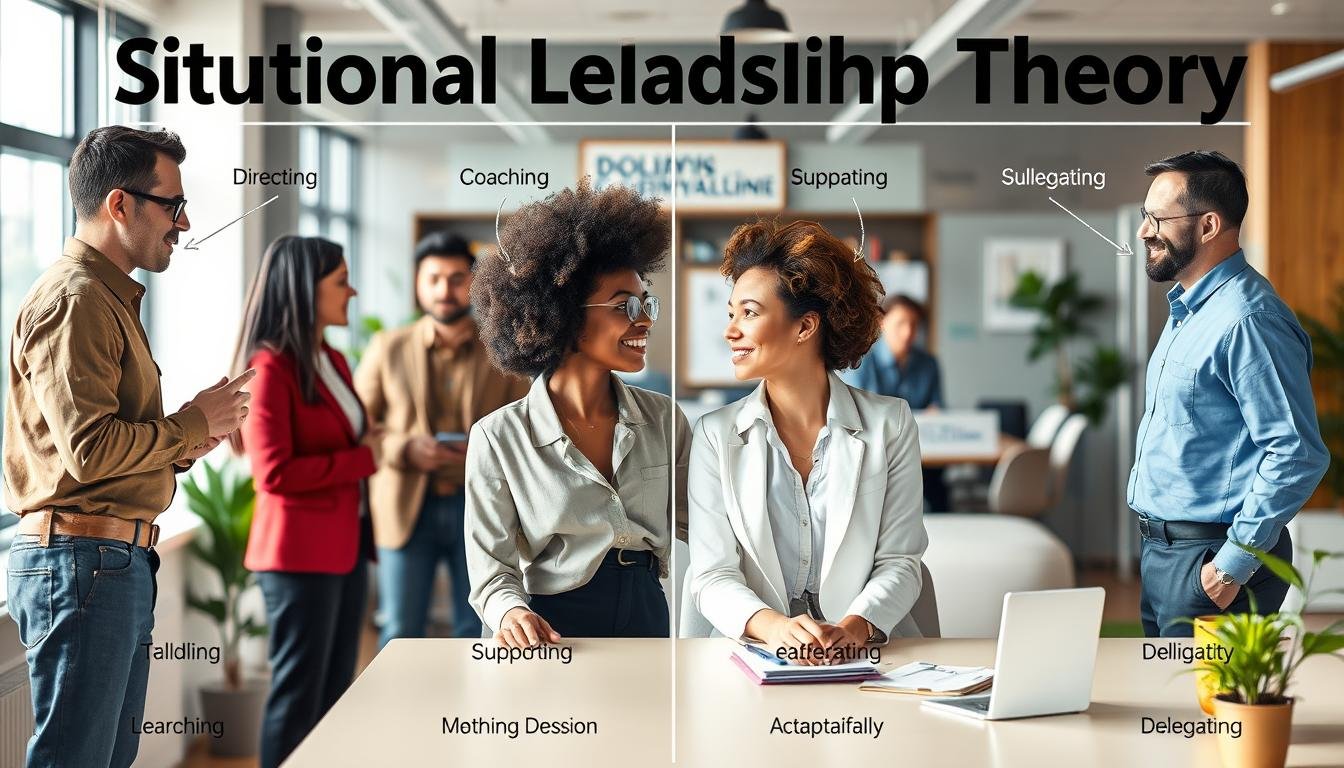Mastering Situational Leadership Theory Explained
Have you ever thought about why some leaders get their teams to follow them easily, while others can’t seem to make a mark? This mystery often points to the Situational Leadership Theory. This idea was first brought to light by Paul Hersey and Ken Blanchard more than fifty years ago. Today, in our fast-changing work environments, being a good leader means knowing how to adapt. This article will explore the main ideas of Situational Leadership Theory. It will show how it’s crucial for improving leadership skills and team work. Learn how using this method can help leaders and their teams grow a lot.
Key Takeaways
- Effective leadership is about adapting to your team’s readiness and skills.
- The Situational Leadership Theory was developed by Paul Hersey and Ken Blanchard in 1969.
- Over 15 million leaders have been trained in the Situational Leadership® model.
- There is no one-size-fits-all approach; leaders must tailor their style to each situation.
- The model includes four leadership styles aimed at matching leader behavior with team competence.
- Situational leadership strategies can empower teams and enhance overall performance.
Understanding Situational Leadership Theory
Situational Leadership Theory changed how we see leader-follower relationships. It says effective leadership means changing your style based on your team’s skills and commitment. This approach recognizes that people have different levels of maturity, helping leaders pick the best approach in different situations.
Overview of Situational Leadership
This theory offers various leadership styles for different tasks and team capabilities. Leaders can choose to delegate, participate, sell, or tell, depending on what’s needed. This makes the work environment dynamic, boosting team engagement and productivity.
Origins by Hersey and Blanchard
Paul Hersey and Ken Blanchard introduced this framework in 1969 through “Management of Organizational Behavior: Utilizing Human Resources.” It’s been widely used in many Fortune 500 companies. The key idea is that leaders should adjust their style to match their team’s readiness and maturity. Hersey and Blanchard show how leadership involves understanding and adapting to team skills for better strategies.
The Four Leadership Styles in Situational Leadership
The Situational Leadership Model shows four main leadership styles. These styles change based on how skilled and committed team members are. Leaders use these styles to match the needs of their team, making sure they get the right kind of help and guidance.
Knowing these styles is key to managing teams well and helping employees grow. It’s all about fitting the right style to the right situation.
Directing (S1)
The directing style is for leaders who give clear instructions to team members who are new or not very skilled. It’s all about telling them exactly what to do, which is great for jobs that need to follow strict rules, like building things or making products. Leaders make sure everyone knows their job and how to do it right.
Coaching (S2)
For team members who want to learn but need more skill, coaching is the way to go. This style mixes clear instructions with building a good relationship. Leaders help team members grow by guiding them and boosting their spirits. This helps everyone keep learning and getting better at their jobs.
Supporting (S3)
When team members are skilled but might not feel confident, supporting is the best approach. It means giving them less guidance but a lot of support and praise. Leaders use this to help team members feel strong and capable, which makes them more confident and skilled at work.
Delegating (S4)
Delegating is for team members who are very skilled and committed. Leaders give them a lot of freedom and trust them to make decisions. This style encourages teamwork and makes team members feel responsible for their work.
| Leadership Style | Task Direction | Relationship Behavior | Follower Competence | Follower Commitment |
|---|---|---|---|---|
| Directing (S1) | High | Low | Low | Low |
| Coaching (S2) | High | High | Low | High |
| Supporting (S3) | Low | High | High | Variable |
| Delegating (S4) | Low | Low | High | High |
Matching Leadership Styles with Employee Competence
Matching leadership styles with employee skills is key to good management. Leaders need to check how well their team members are doing. This helps them pick the best approach. It makes sure the team grows and does better.
Development Levels of Team Members
Hersey and Blanchard’s Situational Leadership Theory says team members are at different levels. These levels show how much they know, can do, and want to do tasks. Leaders must know these levels to lead well.
- M1: Low competence and low commitment, requiring Telling (S1) leadership.
- M2: Some competence but low commitment, suited for Selling (S2) leadership.
- M3: High competence but variable commitment, ideal for Participating (S3) leadership.
- M4: High competence and high commitment, enabling Delegating (S4) leadership.
Situational Leadership Application
Situational Leadership Theory says leaders should change their style based on the team’s skills. For example, a leader with an M1 employee should guide them more. But, someone at M4 level should make their own decisions. This way, everyone grows and the team works better together.
Good leadership means always checking how mature your team members are. Leaders who adjust to their team’s growth can help them reach their goals. This makes the team stronger and more effective.
Benefits of Utilizing Situational Leadership Theory
Situational Leadership Theory offers big benefits to companies. It helps employees grow and work better together. It meets the different needs of employees, making a place where they can do their best. This leads to better team work.
Promoting Employee Growth and Development
Using Situational Leadership Theory, leaders can see what their team members need to grow. This approach helps employees grow in many ways:
- Understanding individual capabilities: Leaders check the strengths and weaknesses of each employee.
- Adaptive coaching: Leaders change how they lead to match what each employee can do.
- Continuous feedback: Giving feedback and advice helps create a growth culture.
Enhancing Team Dynamics and Communication
Good communication is key in Situational Leadership Theory. Leaders must make sure everyone knows what to do. Some ways to improve communication include:
- Role clarity: Everyone knowing their job reduces confusion and helps the team work together better.
- Frequent check-ins: Regular talks keep communication strong and encourage feedback.
- Open dialogue: A place where people feel safe to share ideas and concerns builds trust.
With these methods, teams work together better. Studies show that 75% of workers say working together is key to being engaged. On the other hand, 86% of top managers say not working together causes problems. These facts show how important good communication is in teams using Situational Leadership Theory.
| Benefits | Details |
|---|---|
| Promotes Employee Growth | Changes to fit individual needs, improving skills with focused leadership. |
| Improves Team Dynamics | Boosts teamwork and sets clear roles in the team. |
| Enhances Communication | Makes talking and setting clear expectations better, leading to improved interactions. |
| Increases Engagement | Meets different backgrounds and skills, creating a team that includes everyone. |
Core Qualities of Effective Situational Leaders
Effective situational leaders have certain qualities that help them connect with their teams and tackle challenges. These qualities are key for building a place where emotional smarts, trust, and working together can grow.
Emotional Intelligence in Leadership
Emotional smarts is a key part of being a good leader. Leaders with high emotional smarts can understand their team members’ feelings and needs. They adjust their plans to fit these needs. This makes communication better and builds strong relationships, based on trust.
Flexibility and Adaptability
Being flexible and adaptable is crucial for situational leaders. As work changes, leaders must change too. They look at each situation and adjust their leadership to fit their team’s needs and the task.
Building Trust and Collaboration
A great leader focuses on building trust and teamwork. They make a place where everyone feels important and involved in making decisions. By encouraging teamwork, leaders boost the team’s performance and lead more effectively.
Situational Leadership Theory in Practice
Using situational leadership in a company means knowing how teams work and what each member needs. Ken Blanchard and Paul Hersey created this method over 50 years ago. It’s about changing how leaders act based on what their team can do and wants. Leaders must check how capable each team member is and create a place where leaders can do well.
Implementing Situational Leadership in Organizations
To use situational leadership well, leaders should:
- Assess Employee Readiness: Use the R1-R4 scale to see how ready the team is. This matches with the D1-D4 leadership styles. Each level needs a certain leadership style, making sure leaders meet their team where they are.
- Provide Training and Support: Put money into workshops and training to help leaders know how to see where their team members are in development. This makes leaders better at leading and being flexible.
- Encourage Flexibility: Leaders need to change how they lead in different situations. This builds trust and teamwork.
- Utilize Different Leadership Styles: Use the four main situational leadership styles: Directing (S1), Coaching (S2), Supporting (S3), and Delegating (S4). Each style meets different employee needs.
- Focus on Employee Development: The main goal is to help team members grow and get better. Leaders should always be ready to adapt to help with this growth.
| Leadership Style | Description | Team Readiness Level |
|---|---|---|
| Directing (S1) | Provides clear instructions and closely supervises task completion. | R1 – Low competence and high commitment |
| Coaching (S2) | Encourages employee involvement while maintaining direction. | R2 – Some competence and variable commitment |
| Supporting (S3) | Facilitates team autonomy and shares decision-making. | R3 – Moderate to high competence and variable commitment |
| Delegating (S4) | Assigns tasks with minimal oversight, relying on team members’ abilities. | R4 – High competence and high commitment |
By following these steps, leaders can use situational leadership well. This leads to better performance from individuals and the whole company. This approach lets companies do well in changing situations, making sure every team member adds to the team’s success.
Conclusion
Learning Situational Leadership Theory is key for leaders in today’s fast-changing work world. This approach helps leaders handle team dynamics and keep their teams motivated and engaged. It offers four leadership styles—Directing, Coaching, Supporting, and Delegating—to match the level of development of team members. This leads to better productivity and job happiness.
The success of this leadership model depends on regularly checking team members’ skills and commitment. By changing their leadership style to fit team needs, leaders improve communication and teamwork. Situational Leadership Theory is useful in many areas like project management and helping employees grow. It’s a powerful tool for achieving success in organizations.
Being able to change leadership styles based on team readiness not only builds strong emotional connections. It also sets the stage for lasting growth. By using Situational Leadership, leaders can guide their teams to both personal and team success. This makes them key to adapting and being effective in the workplace.
Source Links
- Situational Leadership®
- Mastering Situational Leadership: The Secret to Thriving Organizations
- The Four Leadership Styles of Situational Leadership®
- What Is Situational Leadership?
- Situational Leadership® Theory
- Situational Leadership (Hersey-Blanchard) Model: How It Works
- Situational Leadership® Quadrants: Four Different Styles
- Understanding the Four Types of Situational Leadership Styles
- Situational Theories of Leadership | Principles of Management
- Why the Most Effective Leaders Know How to Adapt to the Situation
- The Pros & Cons of Situational Leadership®
- The 15 genuine benefits of Situational Leadership in 2023
- 16 Advantages & Disadvantages Of Situational Leadership | MTD Training
- Seven Key Characteristics of Situational Leaders
- Mastering Situational Leadership®: Your guide to adaptive management
- Mastering Situational Leadership®: Your guide to adaptive management
- How To Use Situational Leadership Theory To Be A Better Manager
- What Is Situational Leadership, and How Do You Practice It?
- Situational Leadership
- Situational Leadership – Summary – Develop The Edge







